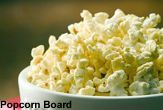Scientists Discover the Secret of Popcorn's Popability

Yes, those unpopped kernels of corn can break a tooth. But for most of us, they're just an annoying disappointment as the edible bits dwindle before the movie is over.
Not all corn pops well. A new study found that out of 14 varieties of popcorn, the number of unpopped kernels ranged from 4 percent to a staggering 47 percent.
More important, the study may reveal how to make better popcorn.
"We think the secret to maximizing 'pop-ability' is found in the special chemistry of the corn kernel," says Bruce Hamaker, a food chemist at Purdue University. "We now have a better understanding of the science behind why unpopped kernels occur and how we can use this knowledge to go about reducing their number."
Big business
This is obviously an important pursuit. Americans consume 17 billion quarts of popped popcorn every year, according to an industry group called the Popcorn Board. That's 54 quarts per man, woman and child.
American farmers produce more than 300 million tons of corn a year, nearly half the world's production.
Get the world’s most fascinating discoveries delivered straight to your inbox.
Orville Redenbacher, Paul Newman and the others who sell popcorn seek corn known to pop well. The industry sometimes claims 98 percent popability. Feel free to test that claim at home.
Hamaker's team has uncovered the crystalline structure in popcorn that appears to govern whether it pops or not.
The key seems to be the varying chemical structure of the outer hull. As the kernels heat up, the hull acts like a pressure cooker to lock moisture inside. Pressure builds until the kernel ruptures, turning it inside out.
Good poppers have a stronger hull with a highly ordered crystalline structure, the investigation found.
Coming to your microwave
Hamaker and his colleagues say future research should be able to determine how to transfer the best hull properties to other corn kernels, perhaps through selective breeding, genetic engineering, or even by simply adding chemicals to modify the hulls.
Improved microwave popcorn could be on grocery shelves within five years, Hamaker said.
The study, funded by Purdue, will be published July 11 in the American Chemical Society's journal BioMacromolecules.
Robert is an independent health and science journalist and writer based in Phoenix, Arizona. He is a former editor-in-chief of Live Science with over 20 years of experience as a reporter and editor. He has worked on websites such as Space.com and Tom's Guide, and is a contributor on Medium, covering how we age and how to optimize the mind and body through time. He has a journalism degree from Humboldt State University in California.



